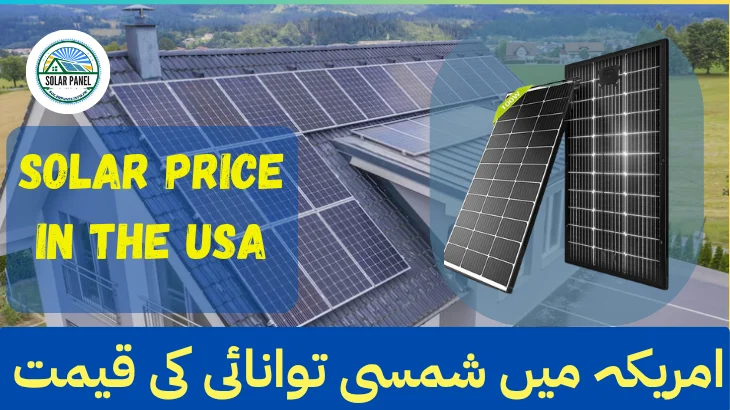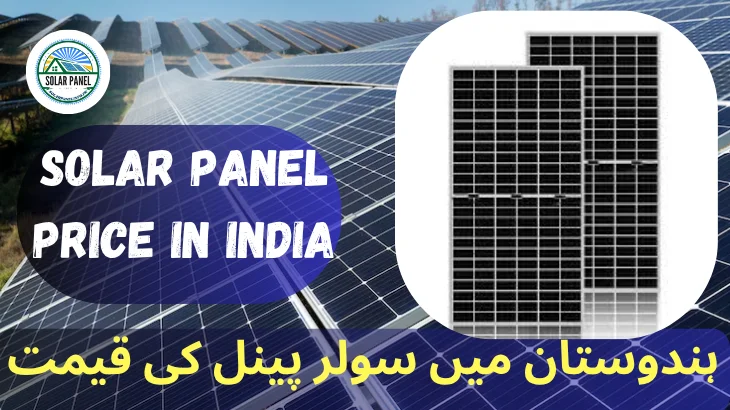Solar Price in the USA
In recent years, solar energy has emerged as a significant and sustainable alternative to fossil fuels in the United States. With rising concerns about climate change and the desire for energy independence, more Americans are turning to solar panels to power their homes and businesses. Here, we will discuss the Solar Price in the USA.
Read more: Solar Panel Price in South Africa

One of the most common questions is: What is the current cost of solar energy in the USA? In this article, we’ll take a friendly look at today’s pricing, trends, the factors that influence costs, and what the future holds for solar power in the United States.
Current Average Price of Solar Panels in the USA
As of 2025, the average price of residential solar panels in the United States falls within the range of $2.40 to $3.20 per watt, not including any available incentives. For homeowners looking to install a typical 6-kilowatt (kW) solar system, this pricing translates to a total cost that potential buyers should consider when evaluating their investment in solar energy.
- Gross Cost: $14,400 – $19,200
- Net Cost (after federal tax credit of 30%): $10,080 – $13,440
Prices can vary depending on location, installer, system size, and panel quality.
Key Factors Affecting Solar Prices
The cost of solar installation in the U.S. is influenced by several factors, including system size, type of solar technology used, installation complexity, and available incentives or rebates. Additionally, regional differences in labor and permitting fees, as well as local solar resources, can also play a significant role in determining the overall price. Understanding these factors can help homeowners and businesses make informed decisions when considering solar energy solutions.
System Size
Larger systems typically benefit from economies of scale, leading to a reduced cost per watt. However, it is important to note that the overall project cost is higher when considering the size of the system.
Panel Type and Efficiency
- Monocrystalline panels (more efficient, higher cost)
- Polycrystalline panels (less efficient, lower cost)
- Thin-film panels (cheapest, but least efficient)
Installation & Labor Costs
Installation costs can significantly impact the overall expenses of a project, constituting up to 25% of the total system cost. Factors such as labor rates, permit fees, and regional pricing variations play a crucial role in determining these installation costs.
Read more: Solar panel installation plan
Incentives and Rebates
The federal Investment Tax Credit (ITC) provides a substantial 30% deduction on the total cost of eligible solar energy systems through the year 2032. In addition to the federal incentive, several states offer various benefits, including
- State tax credits
- Property tax exemptions
- Solar Renewable Energy Credits (SRECs)
- Net metering programs
These incentives can significantly enhance the financial feasibility of investing in solar energy.
Local Electricity Rates
In regions where electricity costs are high, solar energy systems become increasingly appealing due to their potential for faster returns on investment. This makes solar power a viable option for individuals and businesses looking to reduce their energy expenses.
Cost Comparison: Solar vs. Traditional Electricity
The Levelized Cost of Energy (LCOE) for residential solar power is approximately 6 to 8 cents per kilowatt-hour (kWh). In contrast, the national average electricity rate from utility providers ranges from about 15 to 18 cents per kWh. Over a typical lifespan of 25 years for solar panels, homeowners have the potential to save tens of thousands of dollars, depending on factors such as the size of the solar system and local electricity rates.
Financing Options
Not everyone pays upfront for solar. Common financing options include:
Solar Panels Loans
Here are some important aspects to consider
- Fixed monthly payments provide predictable budgeting for your expenses.
- When you own the system, you may be eligible for various tax credits, enhancing your financial benefits.
- Many options are available with zero or low down payments, making it more accessible to get started.
Solar Leases / Power Purchase Agreements (PPAs)
- No initial investment required
- Reduced monthly energy expenses
- System ownership remains with the provider (no eligibility for tax credits)
PACE Programs (Property Assessed Clean Energy)
Financing options are now included in property tax bills, available in select states.
Solar Price Trends Over Time
The cost of solar energy in the USA has seen a significant decline of over 70% since 2010. This drop can be attributed to several key factors, including technological advancements, economies of scale, improvements in manufacturing processes, and dynamic competition within the market.
In 2010, the price of solar systems was more than $7 per watt. Today, that cost has fallen to below $3 per watt, with expectations of further reductions in the future.
Regional Pricing Variations
Solar prices vary significantly across states. Here are a few examples (2025 estimates, pre-incentives):
| State | Avg.. Cost per Watt | Avg 6 kW System |
| California | $2.70 | $16,200 |
| Texas | $2.50 | $15,000 |
| New York | $3.10 | $18,600 |
| Florida | $2.60 | $15,600 |
| Arizona | $2.40 | $14,400 |
States that offer robust incentive programs or experience abundant sunshine typically have lower effective prices for solar energy and shorter payback periods for investments in solar technology.
Future Outlook
The solar sector in the United States is set for ongoing expansion. Prominent trends involve
- Growth of community solar initiatives
- Advancements in energy storage solutions (batteries)
- Incorporation of smart grid technologies
- Declining battery costs are enhancing the feasibility of solar combined with storage
- Possible new federal and state regulations supporting clean energy initiatives
By the year 2030, experts anticipate that solar energy will have the potential to provide as much as 20% of electricity in the United States. This projection is largely attributed to the declining costs of solar technology and a growing demand for sustainable energy solutions.
Conclusion
Solar energy is increasingly affordable and practical for Americans aiming to lower energy costs and environmental impact. Prices have significantly decreased over the past decade, supported by federal and state incentives. While costs vary by system size, location, and technology, solar power offers long-term savings and environmental advantages. Innovations in energy storage and grid technology suggest a promising future for widespread solar adoption.
FAQs
How much can I save by installing solar panels in the USA?
Solar panels can reduce electricity bills by 50% to 90%, with savings dependent on system size, electricity rates, incentives, and sunlight exposure, potentially totaling thousands over 25 years.
Are there any government incentives available to reduce the cost of solar panels?
The federal Investment Tax Credit (ITC) lets you deduct 30% of solar system costs from federal taxes until 2032. States and local governments may also offer additional tax credits and rebates to lower costs.
What financing options are available if I can’t afford to pay for solar panels upfront?
There are financing options for solar energy without upfront payment, such as solar loans, solar leases, PPAs, and PACE programs. Choose the option that best fits your financial goals.


